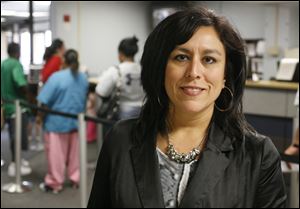
Lucas County OKs plan to get into compliance
Welfare recipients must work 30 hours a week under U.S. rules
12/4/2011
Deb Ortiz-Flores, Department of Job and Family Services director, said 2,841 families receive assistance in Lucas County.
The Lucas County commissioners have approved a plan aimed at getting the county -- and ultimately the state -- into compliance with federal rules requiring welfare recipients put in 30 hours at work or work training each week.
A requirement for getting cash through the Temporary Assistance to Needy Families (TANF) is that adults work or participate in a work experience or work training program 30 hours a week, with no pay other than their TANF assistance.
The federal government requires states to have at least 50 percent of TANF recipients meet the 30-hour goal, but Ohio has been targeted by the U.S. Department of Health and Human Services of failing to keep pace.
Deb Ortiz-Flores, director of the county Department of Job and Family Services, said the counties are under pressure from the state to comply with the participation rates, or the state will be penalized with the loss of federal funds that the state will have to make up.
Ohio is threatened with penalties of $32.7 million from Health and Human Services for failing to meet the requirement for the year 2007, $45 million for 2008, and $58.5 million for 2009.
"Our job is to make sure people are aware of what's required when they receive a cash grant. It's not just free money," she said. "People have to be participating. They have to be in work experience or job search."
Ms. Ortiz-Flores said 2,841 families receive cash assistance in Lucas County.
Lucas County's rate of compliance for 2011 is about 33 percent, Ms. Ortiz-Flores said.
The county's compliance plan, which was sent to the state on Wednesday, is a 12-page document emphasizing the use of closer monitoring and technology to match welfare recipients with work or work training opportunities.
The state's Work Experience Program is designed to help participants meet the guidelines, Ms. Ortiz-Flores said. Lucas County uses a contractor, Bridges, at a cost this year of about $2 million, to help welfare recipients get work and job training opportunities.
The county has about 138 businesses that have made slots available for welfare recipients to work. The work sites are located all over Lucas County to accommodate recipients who have transportation problems, she said.
One such work site is Brent Industries Inc., an industrial laundry business at 2922 South Ave. The company is approved for 20 slots.
Plant Manager Tara Seibert said there may be four or five welfare clients on a typical day.
"They just help out in areas we might be behind on. We've been doing it at least three to four years, and we do hire," Ms. Seibert said.
"I would say it goes both ways. They get the work experience they need, and we get to screen employees."
The clients work up to two weeks, typically putting in two or three days a week for about six hours a day, she said.
Ohio was among six states failing to meet work goals in 2009 -- the most recent year for which statistics are available -- and one of only three to miss the mark for three consecutive years, according to Health and Human Services. California and Maine were the two others.
Lucas County has increased its participation rate in the last three years, from 23 percent in 2009 and 2010 to 33 percent for 2011 so far. It ranks behind Hamilton County with a 46 percent participation rate, and ahead of Montgomery, Franklin, Summit, and Cuyahoga counties.
Under OWF and the Temporary Assistance to Needy Families program, Ohio provides cash to eligible needy families for up to 36 months. About 214,000 Ohioans get the benefit.
According to the state Department of Job and Family Services, all recipients have children, and many earn less than $7,000 per year. The size of the cash grants depends on the size of the household. A four-person household would receive $555 per month of cash benefits.
Under the 1996 welfare reform law, recipients can get benefits up to five years in their lifetime.
The state's action plan, signed Sept. 27 by Gov. John Kasich, vows to get into compliance, but cites barriers to getting up to the 50 percent participation rate.
For example, only a part of the 30-hour-per-week requirement can be used for getting general education.
"It is extremely difficulty to place heads of households without high school diplomas in allowable work activities while they work to complete their high school equivalency," the plan notes.
And it notes that the recession has reduced the number of partners willing or able to provide work opportunities.
Contact Tom Troy at tomtroy@theblade.com or 419-724-6058.